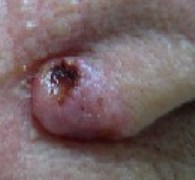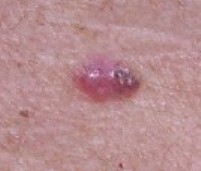What it is:
Basal cell carcinoma (BCC) is the most common form of skin cancer, affecting approximately 2 million Americans each year. Almost all BCC occur on parts of the body exposed to the sun, including the face, ears, neck, scalp, shoulders, and back. However, BCC can also occur on areas of the body that are rarely/never exposed to the sun. BCC seldom spreads (metastasizes), to other parts of the body, but it can damage surrounding tissues. If left untreated, BCC can be very damaging and disfiguring. When caught early, BCC is easily treated. People who have had one BCC are at risk for developing others over the years, either in the same spot or other areas on the body.
What it looks like:
- A reddish patch or irritated area that may crust, itch or hurt.
- A shiny bump or nodule that is pearly or translucent and is often pink, red or white.
- A pink growth with a slightly elevated rolled border and a crusted indentation in the center. As the growth gets bigger, tiny blood vessels may develop on the surface.
- A scar-like area which is white, yellow or waxy, and often has poorly defined borders.
- An open sore that bleeds, oozes, or crusts and remains open for a few weeks, heals and then comes back.


How we treat it:
BCC may be treated by scraping away most of the affected area and then removing the remaining bad cells with a small hot cauterizing pen. This procedure is called curettage and electrodessication and is done with a local anesthetic. Other treatments for BCC include topical skin cream, or surgical excision. BCC located on the head or face should be treated by Moh’s surgery which is a surgical technique used to minimize the amount of tissue removed. New oral treatments, such as Erivedge (vismodegib) or Odomzo (sonidegib) are also available to some patients.
Call (520) 694-2873 for an appointment


